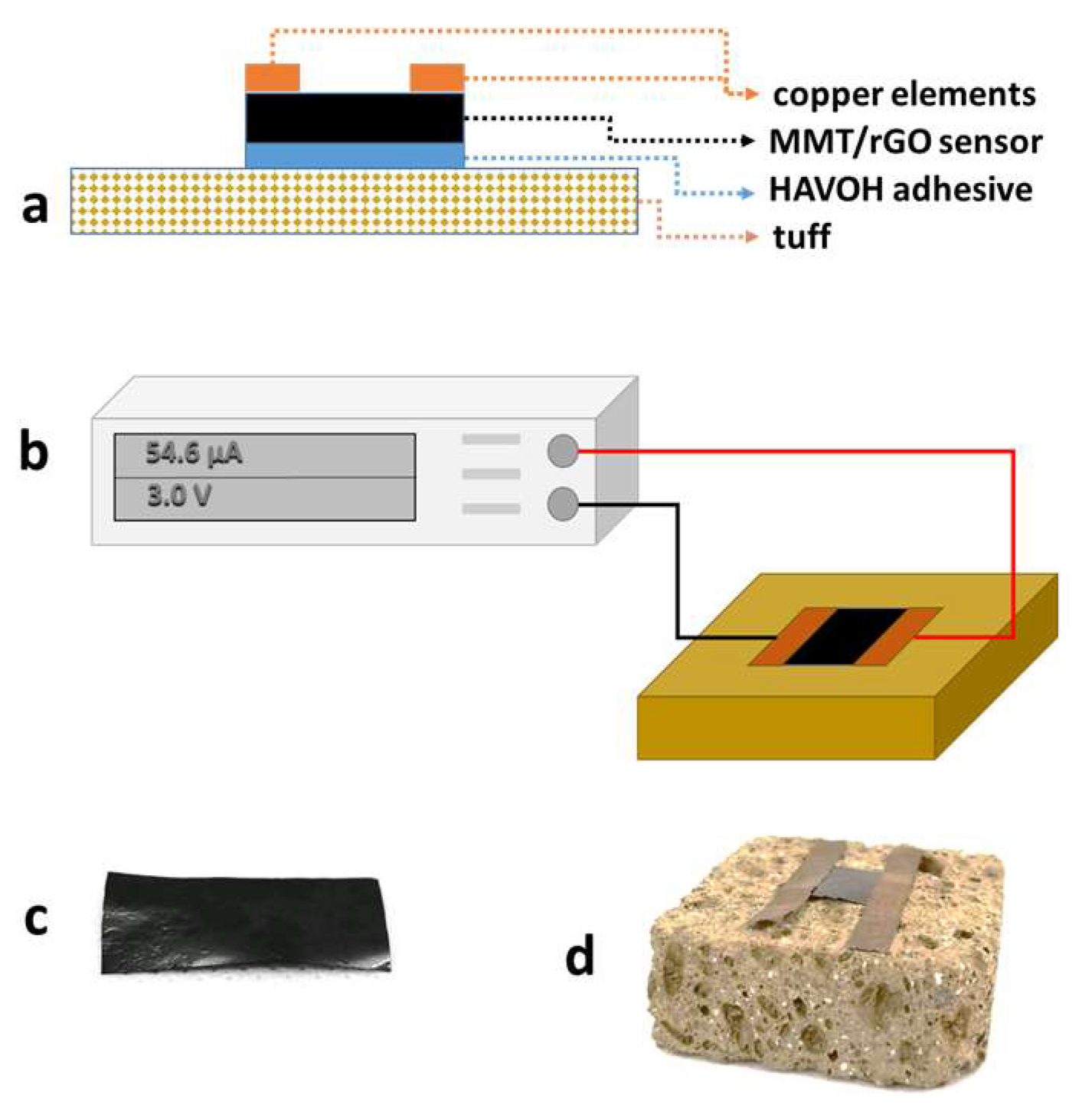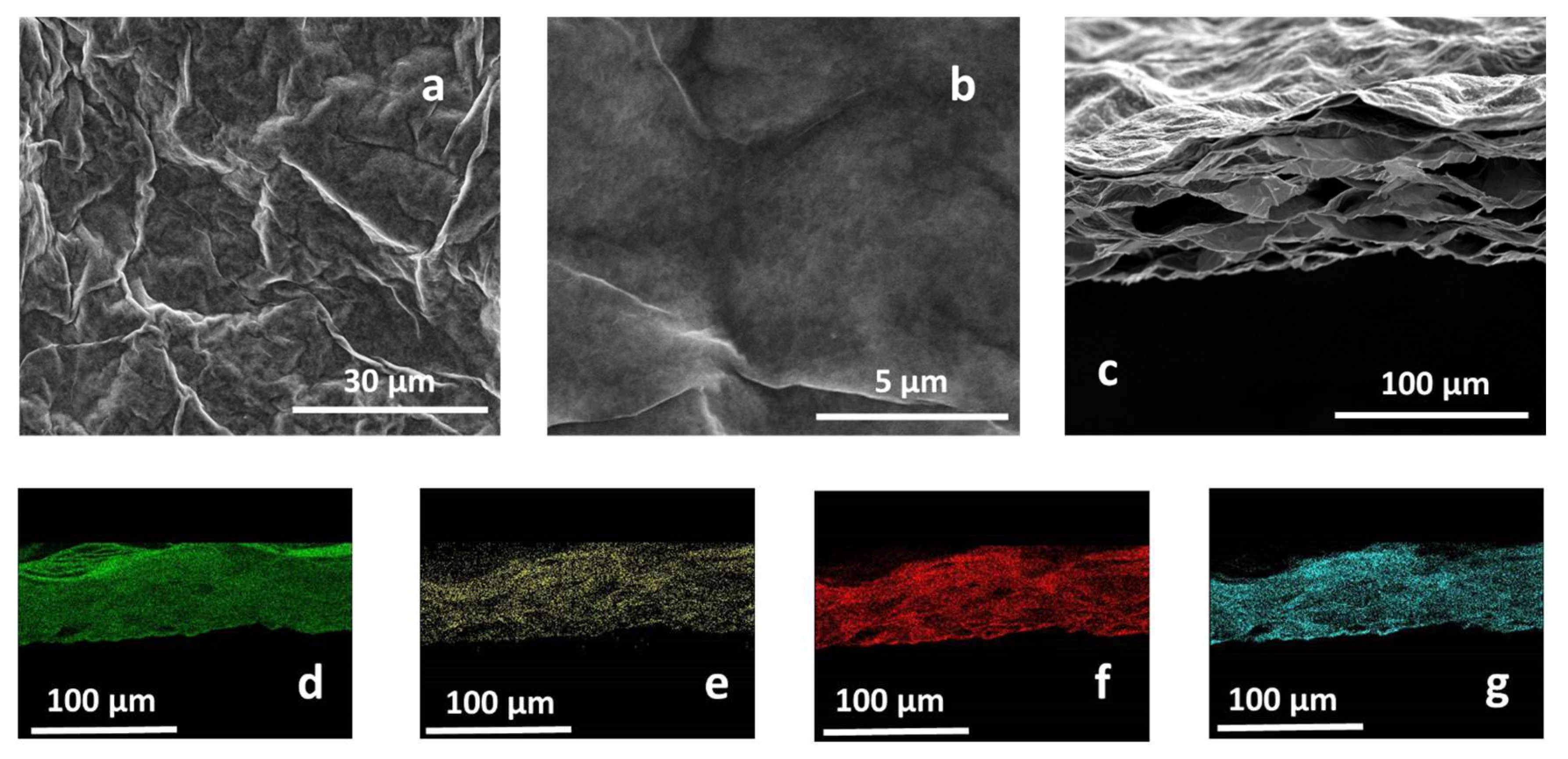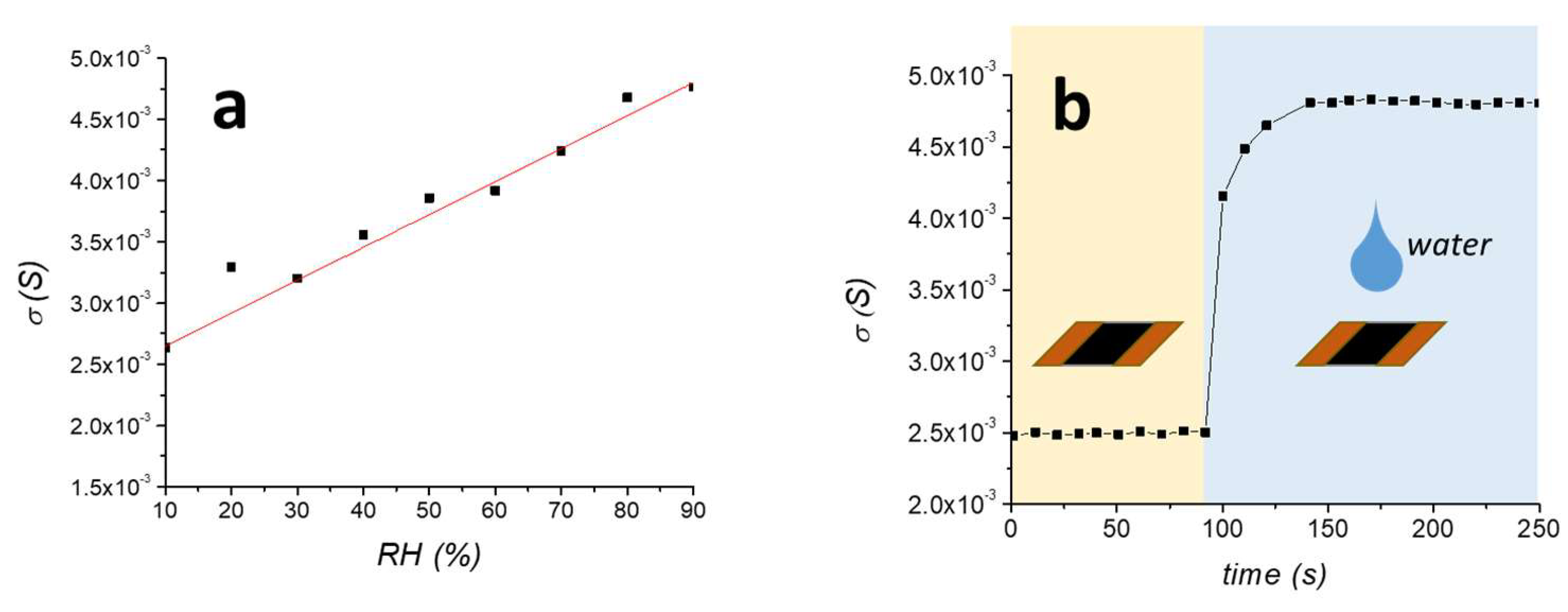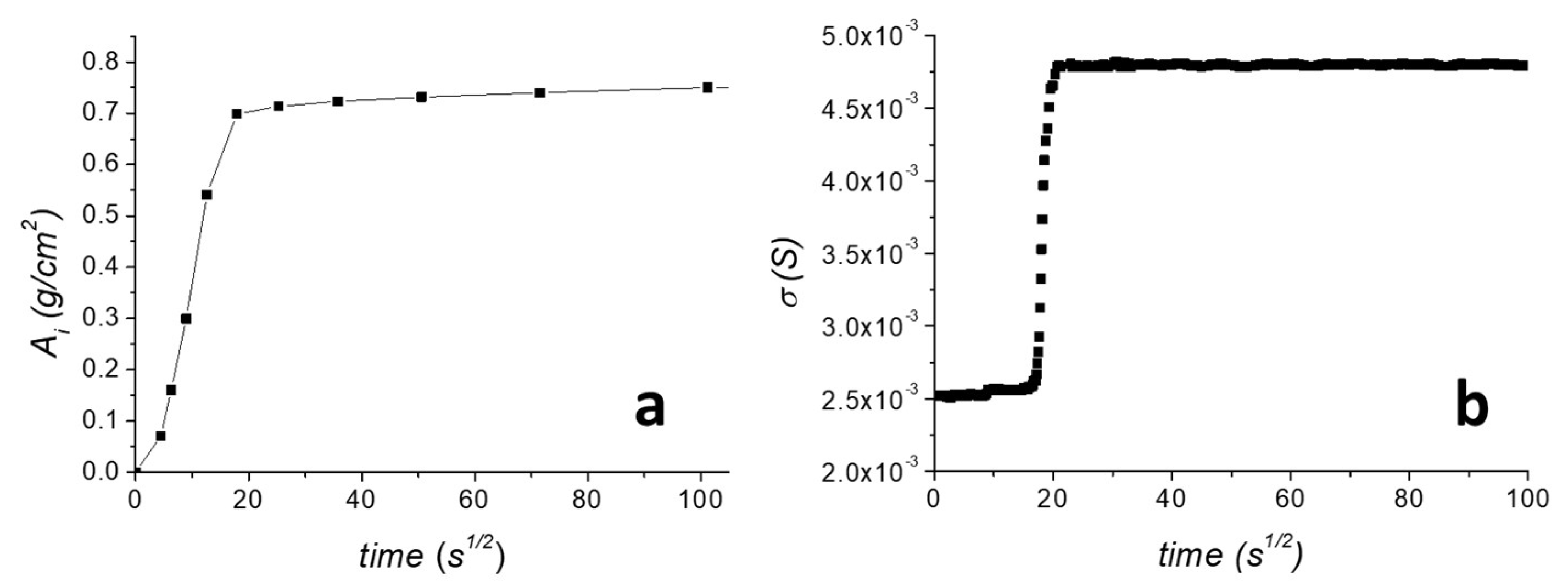Monitoring Water Absorption and Desorption in Untreated and Consolidated Tuff by a Non-Invasive Graphene-Based Humidity Sensor
Abstract
:1. Introduction
2. Materials and Methods
2.1. Materials
2.2. Sample Impregnation and Evaluation of the Amount of Consolidating Agent Applied
2.3. Film Preparation
2.4. Sensor Application
2.5. Morphological Characterisation
2.6. Capillary Absorption and Desorption Tests
2.7. Electrical Characterisation
3. Results
3.1. MMT/rGO Film Characterszation
3.2. Water Capillary Absorption
3.3. Drying Index
4. Concluding Remarks
Supplementary Materials
Author Contributions
Funding
Data Availability Statement
Conflicts of Interest
References
- Klemm, A.; Wiggins, D. Sustainability of natural stone as a construction material. In Sustainability of Construction Materials; Woodhead Publishing: Cambridge, UK, 2016; pp. 283–308. [Google Scholar]
- Freire-Lista, D.M. The forerunners on heritage stones investigation: Historical synthesis and evolution. Heritage 2021, 4, 1228–1268. [Google Scholar] [CrossRef]
- Smith, B.J.; Gomez-Heras, M.; McCabe, S. Understanding the decay of stone-built cultural heritage. Prog. Phys. Geogr. Earth Environ. 2008, 32, 439–461. [Google Scholar] [CrossRef]
- Van Grieken, R.; Delalieux, F.; Gysels, K. Cultural heritage and the environment. Pure Appl. Chem. 1998, 70, 2327–2331. [Google Scholar] [CrossRef] [Green Version]
- Piacenti, F. Chemistry for the conservation of the cultural heritage. Sci. Total Environ. 1994, 143, 113–120. [Google Scholar] [CrossRef]
- Camaiti, M.; Bortolotti, V.; Fantazzini, P. Stone porosity, wettability changes and other features detected by MRI and NMR relaxometry: A more than 15-year study. Magn. Reson. Chem. 2014, 53, 34–47. [Google Scholar] [CrossRef]
- Warscheid, T.; Braams, J. Biodeterioration of stone: A review. Int. Biodeterior. Biodegrad. 2000, 46, 343–368. [Google Scholar] [CrossRef]
- Borgia, G.C.; Camaiti, M.; Cerri, F.; Fantazzini, P.; Piacenti, F. Hydrophobic Treatments for Stone Conservation—Influence of the Application Method on Penetration, Distribution and Efficiency. Stud. Conserv. 2003, 48, 217–226. [Google Scholar] [CrossRef]
- Sbardella, F.; Bracciale, M.P.; Santarelli, M.L.; Asua, J.M. Waterborne modified-silica/acrylates hybrid nanocomposites as surface protective coatings for stone monuments. Prog. Org. Coat. 2020, 149, 105897. [Google Scholar] [CrossRef]
- Toniolo, L.; Poli, T.; Castelvetro, V.; Manariti, A.; Chiantore, O.; Lazzari, M. Tailoring new fluorinated acrylic copolymers as protective coatings for marble. J. Cult. Herit. 2002, 3, 309–316. [Google Scholar] [CrossRef]
- Franzen, C.; Mirwald, P.W. Moisture content of natural stone: Static and dynamic equilibrium with atmospheric humidity. Environ. Geol. 2004, 46, 391–401. [Google Scholar] [CrossRef]
- Mollo, L.; Greco, R. Moisture measurements in masonry materials by time domain reflectometry. J. Mater. Civil Eng. 2011, 23, 441–444. [Google Scholar] [CrossRef]
- Suchorab, Z.; Fiala, L.; Łagód, G.; Kočí, V.; Černý, R. Possibility to use surface TDR sensors to estimate water absorption coefficient of porous materials. AIP Conf. Proc. 2020, 2275, 020028. [Google Scholar] [CrossRef]
- Su, S.L.; Singh, D.N.; Baghini, M.S. A critical review of soil moisture measurement. Measurement 2004, 54, 92–105. [Google Scholar] [CrossRef]
- Benavente, D.; Such-Basañez, I.; Fernandez-Cortes, A.; Pla, C.; Cazorla-Amoros, D.; Cañaveras, J.C.; Sanchez-Moral, S. Comparative analysis of water condensate porosity using mercury intrusion porosimetry and nitrogen and water adsorption techniques in porous building stones. Constr. Build. Mater. 2021, 288, 123131. [Google Scholar] [CrossRef]
- Proietti, N.; Capitani, D.; Di Tullio, V. Applications of Nuclear Magnetic Resonance Sensors to Cultural Heritage. Sensors 2014, 14, 6977–6997. [Google Scholar] [CrossRef] [Green Version]
- Di Tullio, V.; Proietti, N. New Insights to Characterize Paint Varnishes and to Study Water in Paintings by Nuclear Magnetic Resonance Spectroscopy (NMR). Magnetochemistry 2020, 6, 21. [Google Scholar] [CrossRef] [Green Version]
- Aguilar-Castro, K.M.; Flores-Prieto, J.J.; Macías-Melo, E.V. Near infrared reflectance spectroscopy: Moisture content measurement for ceramic plaster. J. Mech. Sci. Technol. 2014, 28, 293–300. [Google Scholar] [CrossRef]
- Barreira, E.; Almeida, R.M.; Moreira, M. An infrared thermography passive approach to assess the effect of leakage points in buildings. Energy Build. 2017, 140, 224–235. [Google Scholar] [CrossRef]
- Ludwig, N.; Rosina, E.; Sansonetti, A. Evaluation and monitoring of water diffusion into stone porous materials by means of innovative IR thermography techniques. Measurement 2018, 118, 348–353. [Google Scholar] [CrossRef] [Green Version]
- Güneyli, H.; Karahan, S.; Güneyli, A. Water content and temperature effect on ultrasonic pulse velocity of concrete. Russ. J. Nondestruct. Test. 2017, 53, 159–166. [Google Scholar] [CrossRef]
- Riminesi, C.; Marie-Victoire, E.; Bouichou, M.; Olmi, R. Moisture and salt monitoring in concrete by evanescent field dielectrometry. Meas. Sci. Technol. 2016, 28, 014002. [Google Scholar] [CrossRef]
- El Abd, A.; Taman, M.; Zhao, Y. A new method for measurement of moisture transport in porous media based on forward and backward scattering of epithermal neutrons. Appl. Radiat. Isot. 2021, 173, 109730. [Google Scholar] [CrossRef] [PubMed]
- Orr, S.A.; Fusade, L.; Young, M.; Stelfox, D.; Leslie, A.; Curran, J.; Viles, H. Moisture monitoring of stone masonry: A comparison of microwave and radar on a granite wall and a sandstone tower. J. Cult. Herit. 2020, 41, 61–73. [Google Scholar] [CrossRef]
- Agliata, R.; Bogaard, T.A.; Greco, R.; Minardo, A.; Mollo, L.; Steele-Dunne, S.C. Non-invasive water content estimation in a tuff wall by DTS. Constr. Build. Mater. 2019, 197, 821–829. [Google Scholar] [CrossRef] [Green Version]
- Ho, S.C.M.; Ren, L.; Li, H.N.; Song, G. A fiber Bragg grating sensor for detection of liquid water in concrete structures. Smart Mater. Struct. 2013, 22, 055012. [Google Scholar] [CrossRef]
- Phillipson, M.C.; Baker, P.H.; Davies, M.; Ye, Z.; McNaughtan, A.; Galbraith, G.H.; McLean, R.C. Moisture measurement in building materials: An overview of current methods and new approaches. Build. Serv. Eng. Res. Technol. 2007, 28, 303–316. [Google Scholar] [CrossRef]
- Ghandehari, M.; Vimer, C.S.; Ioannou, I.; Sidelev, A.; Jin, W.; Spellane, P. In-situ measurement of liquid phase moisture in cement mortar. NDT E Int. 2012, 45, 162–168. [Google Scholar] [CrossRef]
- Avella, M.; Cocca, M.; Errico, M.E.; Gentile, G. Nanotechnologies and nanosensors: Future applications for the conservation of cultural heritage. In Nanotechnological Basis for Advanced Sensors; Reithmaier, J.P., Paunovic, P., Kulisch, W., Popov, C., Petkov, P., Eds.; NATO Science for Peace and Security Series B: Physics and Biophysics book series; Springer: Dordrecht, The Netherlands, 2011; pp. 511–517. [Google Scholar] [CrossRef]
- García, O.; Malaga, K. Definition of the procedure to determine the suitability and durability of an anti-graffiti product for application on cultural heritage porous materials. J. Cult. Herit. 2012, 13, 77–82. [Google Scholar] [CrossRef]
- Castaldo, R.; Lama, G.C.; Aprea, P.; Gentile, G.; Ambrogi, V.; Lavorgna, M.; Cerruti, P. Humidity-driven mechanical and electrical response of graphene/cloisite hybrid films. Adv. Funct. Mater. 2019, 29, 1807744. [Google Scholar] [CrossRef]
- Mohan, V.B.; Brown, R.; Jayaraman, K.; Bhattacharyya, D. Characterisation of reduced graphene oxide: Effects of reduction variables on electrical conductivity. Mater. Sci. Eng. B Solid State Mater. Adv. Technol. 2015, 193, 49–60. [Google Scholar] [CrossRef]
- Ju, H.-M.; Huh, S.H.; Choi, S.-H.; Lee, H.-L. Structures of thermally and chemically reduced graphene. Mater. Lett. 2010, 64, 357–360. [Google Scholar] [CrossRef]
- Castaldo, R.; Avolio, R.; Cocca, M.; Errico, M.E.; Lavorgna, M.; Šalplachta, J.; Santillo, C.; Gentile, G. Hierarchically porous hydrogels and aerogels based on reduced graphene oxide, montmorillonite and hyper-crosslinked resins for water and air remediation. Chem. Eng. J. 2022, 430, 133162. [Google Scholar] [CrossRef]
- Olivieri, F.; Rollo, G.; De Falco, F.; Avolio, R.; Bonadies, I.; Castaldo, R.; Cocca, M.; Errico, M.E.; Lavorgna, M.; Gentile, G. Reduced graphene oxide/polyurethane coatings for wash-durable wearable piezoresistive sensors. Cellulose 2023, 30, 2667–2686. [Google Scholar] [CrossRef]
- Nair, R.R.; Wu, H.A.; Jayaram, P.N.; Grigorieva, I.V.; Geim, A.K. Unimpeded permeation of water through helium-leak–tight graphene based membranes. Science 2012, 335, 442–444. [Google Scholar] [CrossRef] [PubMed] [Green Version]
- Ghosh, S.; Ghosh, R.; Guha, P.K.; Bhattacharyya, T.K. Humidity sensor based on high proton conductivity of graphene oxide. IEEE Trans. Nanotechnol. 2015, 14, 931–937. [Google Scholar] [CrossRef]
- Suchorab, Z.; Tabiś, K.; Brzyski, P.; Szczepaniak, Z.; Rogala, T.; Susek, W.; Łagód, G. Comparison of the Moist Material Relative Permittivity Readouts Using the Non-Invasive Reflectometric Sensors and Microwave Antenna. Sensors 2022, 22, 3622. [Google Scholar] [CrossRef]
- Siegesmund, S.; Pötzl, C.; López-Doncel, R.; Gross, C.J.; Dohrmann, R.; Ufer, K. Overview and quality assessment of volcanic tuffs in the Mexican building heritage. Environ. Earth Sci. 2022, 81, 426. [Google Scholar] [CrossRef]
- Cocca, M.; D’Arienzo, L.; D’Orazio, L.; Gentile, G.; Martuscelli, E. Synthesis of poly (urethane urea) by in situ polymerization inside stone. J. Polym. Sci. B Polym. Phys. 2005, 43, 542–552. [Google Scholar] [CrossRef]
- Cocca, M.; D’Arienzo, L.; D’Orazio, L.; Gentile, G.; Martuscelli, E. In situ Polymerisation of Urethane-Urea Copolymers for Tuff Consolidation. Macromol. Symp. 2005, 228, 245–254. [Google Scholar] [CrossRef]
- Iucolano, F.; Colella, A.; Liguori, B.; Calcaterra, D. Suitability of silica nanoparticles for tuff consolidation. Constr. Build. Mater. 2019, 202, 73–81. [Google Scholar] [CrossRef]
- Di Tullio, V.; Cocca, M.; Avolio, R.; Gentile, G.; Proietti, N.; Ragni, P.; Errico, M.E.; Capitani, D.; Avella, M. Unilateral NMR investigation of multifunctional treatments on stones based on colloidal inorganic and organic nanoparticles. Magn. Reson. Chem. 2015, 53, 64–77. [Google Scholar] [CrossRef] [PubMed]
- Santillo, C.; Godoy, A.P.; Donato, R.K.; Espanhol Andrade, R.J.; Buonocore, G.G.; Xia, H.; Lavorgna, M.; Sorrentino, A. Tuning the structural and functional properties of HAVOH-based composites via ionic liquid tailoring of MWCNTs distribution. Comp. Sci. Technol. 2021, 207, 108742. [Google Scholar] [CrossRef]
- Pinto, A.P.F.; Rodrigues, J.D. Stone consolidation: The role of treatment procedures. J. Cult. Herit. 2008, 9, 38–53. [Google Scholar] [CrossRef]
- EN 15801:2009; Conservation of Cultural Property—Test Methods—Determination of Water Absorption by Capillarity Test. European Committee for Standardization: Brussels, Belgium, 2009.
- EN 16322:2013; Conservation of Cultural Heritage—Test Methods—Determination of Drying Properties. European Committee for Standardization: Brussels, Belgium, 2013.





Disclaimer/Publisher’s Note: The statements, opinions and data contained in all publications are solely those of the individual author(s) and contributor(s) and not of MDPI and/or the editor(s). MDPI and/or the editor(s) disclaim responsibility for any injury to people or property resulting from any ideas, methods, instructions or products referred to in the content. |
© 2023 by the authors. Licensee MDPI, Basel, Switzerland. This article is an open access article distributed under the terms and conditions of the Creative Commons Attribution (CC BY) license (https://creativecommons.org/licenses/by/4.0/).
Share and Cite
Olivieri, F.; Castaldo, R.; Gentile, G.; Lavorgna, M. Monitoring Water Absorption and Desorption in Untreated and Consolidated Tuff by a Non-Invasive Graphene-Based Humidity Sensor. Materials 2023, 16, 1878. https://doi.org/10.3390/ma16051878
Olivieri F, Castaldo R, Gentile G, Lavorgna M. Monitoring Water Absorption and Desorption in Untreated and Consolidated Tuff by a Non-Invasive Graphene-Based Humidity Sensor. Materials. 2023; 16(5):1878. https://doi.org/10.3390/ma16051878
Chicago/Turabian StyleOlivieri, Federico, Rachele Castaldo, Gennaro Gentile, and Marino Lavorgna. 2023. "Monitoring Water Absorption and Desorption in Untreated and Consolidated Tuff by a Non-Invasive Graphene-Based Humidity Sensor" Materials 16, no. 5: 1878. https://doi.org/10.3390/ma16051878
APA StyleOlivieri, F., Castaldo, R., Gentile, G., & Lavorgna, M. (2023). Monitoring Water Absorption and Desorption in Untreated and Consolidated Tuff by a Non-Invasive Graphene-Based Humidity Sensor. Materials, 16(5), 1878. https://doi.org/10.3390/ma16051878









